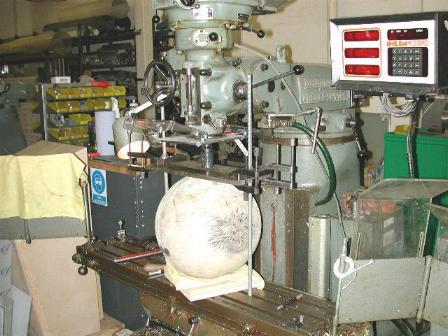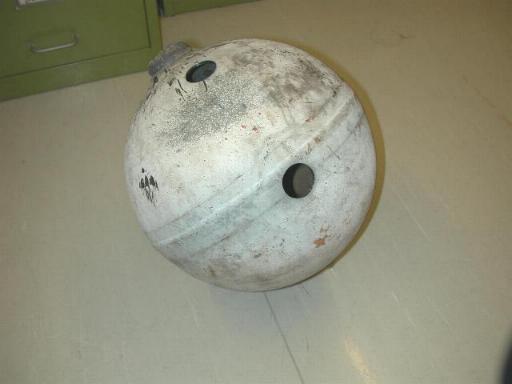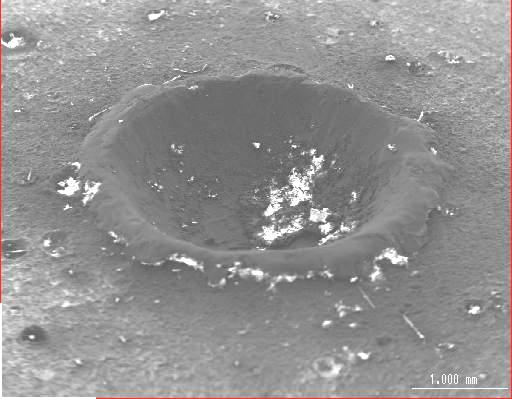![[IMAGE]](https://fernlea.tripod.com/pagehead.gif)
![[IMAGE]](https://fernlea.tripod.com/pagehead.gif)
Salyut 7/Kosmos 1686
Helium Tank
A man-made meteorite.
This is a helium tank from the Russian Salyut 7-Cosmos
1686 (Kosmos 1686) spacecraft assembly, which went out of control
and fell to Earth as a fireball, 3 to 4 years earlier than
expected.
Controllers put the spacecraft into a spin and tried to control
the impact into the Atlantic Ocean as 70Kg of fuel still remained
onboard. This attempt failed and after a bright fireball that was
witnessed by many local people, some fragments fell near the town
of Capitan Bermudez, 400 Km from Buenos Aires, Argentina at 01:00
local time on 7th February 1991.
The 14 inch diameter, 7.4Kg, mostly titanium sphere is peppered
with several hundred perfectly formed craters caused by tiny
micrometeoroids which impacted on the surface during it's many
years in space. Opposing ends have a mounting rod and a coupling/inlet
valve respectively - each has ablated heavily during re-entry and
streamers of molten material have been blown back onto the
leading faces of the sphere, clearly showing the orientation of
flight. Dark scorching on one side of the main body is evidence
that the sphere "flipped" during flight as external
mountings and couplings broke/ablated away, and for a brief few
moments this side was the leading edge before orienting itself
once more. This dark patch of side scorching also shows a much
lighter coloured "shadow" band where another part of
the spacecraft, or possibly the departing mounting rod,
momentarily protected this part of the sphere from scorching.....and
left an outline image of itself in the process.
Due to it's almost perfectly spherical shape and the high melting
point of it's titanium chemistry, the main body of the sphere
escaped complete ablation of it's surface, thus preserving the
many micrometeoroid craters. However, the irregularly shaped
mounting rod and the opposing coupling/inlet valve have a thick
layer of dark fusion crust (!!) with fine flow lines that are
similar to the surface of a freshly recovered iron meteorite.
Some of the crater "pits" were undoubtedly caused by
other parts of the spacecraft that were ablating in front of the
spherical tank during atmospheric passage and also by other man-made
orbiting debris from earlier space missions that impacted during
it's 9+ years in space......fine particulate matter such as paint
flecks, booster vapours and even dumped astronauts' urine!!!!!
This tank has been the subject of much study in the last 12
months with SEM research into the composition of the craters. A
scientific research paper entitled: "Analysis of Impact
Residues on Spacecraft Surfaces: Possibilities and Problems"
has been written about this Salyut helium tank and was presented
at the 3rd European Conference on Space Debris, with a
proceedings paper.

The "front" end of the tank showing the remains of the
mounting rod and heavy ablation features.

The machining of 2 samples for SEM study in the Engineering Dept.
of the Natural History Museum, London.

The "underside" showing where samples have been removed.

Dr.Monica Grady and Dr.Sara Russell in the Mineralogy Department
of the NHM.
The sample "disks" are in the foreground.

Looking somewhat like Meteor Crater from the air, this is
actually an SEI of one of
the meteoroid impact craters on the surface of the helium tank.

More images of the tank prior to sampling.






<< Meteorites for Sale| Home | Next >>

Fernlea, The
Wynd, Milton of Balgonie, Fife. KY7 6PY United Kingdom
Please
- no requests to authenticate old rock and stone finds
I've heard the
"My grandad saw it fall in a field and gave it to me!"
story (and all variations) a zillion times
Telephone: 07880-888660
Email: fernlea4@aol.com
© Rob Elliott